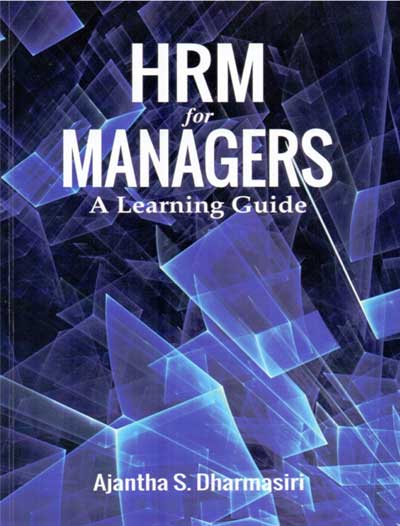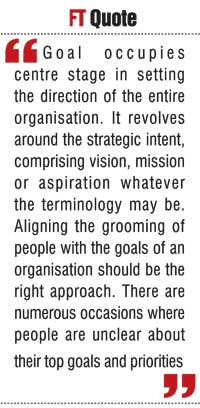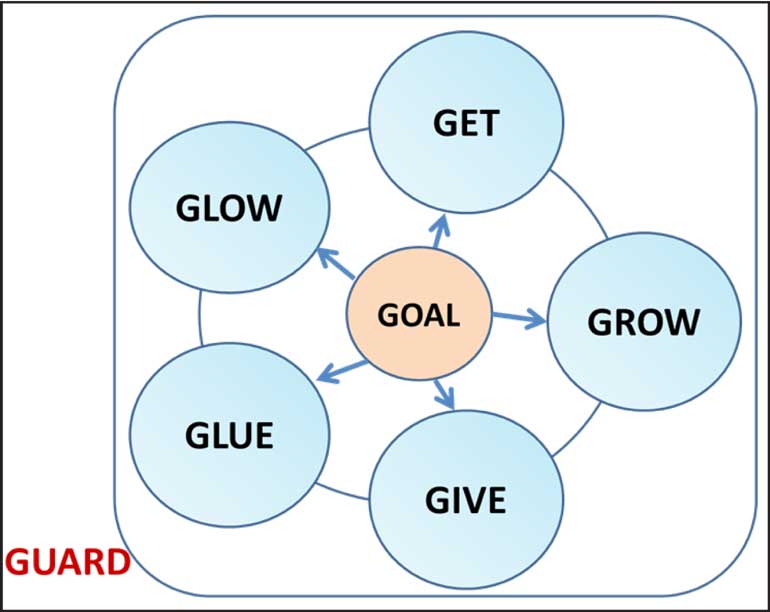Friday Apr 19, 2024
Friday Apr 19, 2024
Monday, 24 August 2015 00:00 - - {{hitsCtrl.values.hits}}

I am delighted to share some thoughts about my newly published sixth book, in fact, the fourth in English in addition to two science fiction stories in Sinhala.
Interestingly, this happens to be the 250th column in the Humane Results series. It gives me double delight to share my thoughts in such a context.
Overview
It was Eleanor Roosevelt who said that the future belongs to those who believe in the beauty of their dreams. ‘HRM for Managers: A Learning Guide’ is one such dream.
The need to create a detailed learning guide on HRM had been a dream of mine for a while. Having left an international career in HRM over a decade ago, knowledge-sharing as a teacher and trainer has been a pivotal part of my professional life. Researching, supervising, coaching consulting and leading have been the other vital roles that I needed to play in my multidimensional career.
Transitioning from an “engineer of electrical” to an “engineer of hearts and minds” has been a key in influencing my thoughts and tasks. Having co-edited a volume of research articles titled ‘HR Challenge’ with the late Prof. Sudaththa Ranasinghe, I wrote two books on HRM, namely, ‘Humane Results’ and ‘People Engineering’.
‘HRM for Managers: A Learning Guide’ is an extension of the endavour of exploring and exchanging knowledge.
The seeds of this book are of twin origins. The first was planted by Adil Malia, Group President – HR of Essar Group India, when he was talking about changing mental models as being HR’s most important task at one of the annual conferences of the Institute of Personnel Management, Sri Lanka. The second was planted by Prof. Uditha Liyanage, former director of the Postgraduate Institute of Management, when he was addressing a group of senior managers of the Central Bank.
Both mentioned the several Gs of managing people, highlighting the need to go back to the basics. Upon reflecting and reinforcing, I initiated the Seven G framework of HRM.
My Seven Gs refer to the means of reaping the best from people. They refer to goal, get, give, grow, glue, glow and guard. Let’s discuss them further. Figure 1 contains the details of the Seven G framework.
Seven Gs in a nutshell
Goal occupies centre stage in setting the direction of the entire organisation. It revolves around the strategic intent, comprising vision, mission or aspiration whatever the terminology may be. Aligning the grooming of people with the goals of an organisation should be the right approach. There are numerous occasions where people are unclear about their top goals and priorities.
Strategic Human Resource Management (SHRM) appears prominently in this context. SHRM is an approach that defines how an  organisation’s goals will be achieved through people by means of HR strategies and integrated HR policies and practices. It is explicitly linking HRM with strategic management processes of the organisation and to emphasise coordination and congruence among the various human resource management practices.
organisation’s goals will be achieved through people by means of HR strategies and integrated HR policies and practices. It is explicitly linking HRM with strategic management processes of the organisation and to emphasise coordination and congruence among the various human resource management practices.
Get is all about getting the right people in. The hiring challenge looms large for an organisation in diverse environments, mainly owing to a talent gap.
“If you give peanuts, you get monkeys”, goes the old saying. What you give to the person who came in by way of reward and recognition is of utmost importance in the context of competition. Your competitor can grab your best talent by ‘giving’ more.
In practical terms, updated job descriptions and job specifications should be available for each position and these should be used in the selection process. Additionally, selecting the appropriate test in predicting future performance on the specific job is of importance. Managers should be trained in effective hiring, with special emphasis on interviewing skills.
Grow refers to the need to build people. Training and development go hand-in-hand. The simple difference is that the former is for current and the latter is for future. In essence, training is to do something. Development is to be someone. Both are intertwined in such a way that training leads to development.
Choices in training and development are captured here. The identification of training and development needs is of utmost importance in this regard. Having clarity on program participants, presenters, designers, coverage, delivery methods and expected behavioural changes are some of the vital components associated.
A growing emphasis on training effectiveness with proper mechanisms to measure is seen in the Sri Lankan private sector. Use of Kirkpatrick model to assess training effectiveness at different levels is one such approach. Return on Training Investment (ROTI) has slowly become a critical factor in the local scenario as well, in justifying the monetary allocation for training and development.
Glue comes next. I would associate the feature ‘binding’ with glue. This refers to the range of choices in retaining talent. Having developed the knowledge and skills of high performers of any organisation, seeing them leaving is the last thing an organisation would like to see. 
Meaningful strategies for employee engagement also become relevant in this context. Devising mechanisms to appeal to ‘head’ (stimulating them intellectually) and ‘heart’ (stimulating them emotionally) of employees is the right way forward.
Having an employee suggestion scheme and aptly rewarding the most value-adding suggestion is one such example. Organising a family day where the loved ones of employees proudly associate with the organisation is another example of strengthening the bond.
Finding out why talented people leave and taking appropriate action to arrest the outflow should be high on the HR agenda. Offering a variety of financial and non-financial rewards to encourage employees to stay is a practice which also needs to be strengthened.
Encouraging evidence can be found in many leading organisations in Sri Lanka. Yet, the reality remains that when overseas opportunities are galore with unmatchable financial offers, employees tend to seek better prospects. As I have seen in many organisations, effectively engaging the employees with a clear purpose can be a sure cure in arresting the rot.
Glow is the subtlest of all. It can appear in several forms. As one such form, choices in promoting the employees can be captured. When a career ladder is available for them to climb, and when the organisation is providing genuine support and encouragement, the chances of them contributing more in a more committed manner are high.
Establishing criteria for new jobs, allowing volunteers to take up challenging tasks, evaluating candidates’ potential and supporting new job holders are some of the key actions in this regard.
Guard is all about employee protection through a proper policy framework. It may include controls as well as clearance for creative action. A widely-shared and willfully practiced set of corporate values also falls into this perspective. A weak guarding may result in employees having uncertainty and ambiguity with regard to their direction, resulting in lower involvement and contribution.

Seven Gs in action
“If you pick the right people and give them the opportunity to spread their wings, and put compensation as a carrier behind it, you almost don’t have to manage them.” So said Jack Welch, a man who was at one point in time the most admired CEO in the world. I see a mixed scene in the Sri Lankan organisations in this respect. Perhaps, an awareness of the Seven Gs for people management and an adherence to the required priorities could be of use.
‘HRM for Managers: A Learning Guide’ is not meant to be a comprehensive textbook. It is a companion for managers in guiding them to learn HRM in a practical manner. It is intended to assist private sector executives and public sector administrators alike, in inviting them to “be brilliant on basics.” The concepts and their usages discussed in the book are relevant to both graduate and postgraduate learners alike.
My invitation is not just to read it, but to recognize the key contents, reflect on the main challenges, relate the basic concepts learnt to the current issues faced by one’s workplace and reinforce the way how one professionally apply the key lessons, in playing a people manager role in one’s workplace.
In essence, knowing should lead to doing and that in turn will deliver results.
May the ‘HRM for Managers: A Learning Guide’ be a collaborator companion in making caring and committed people managers. Let me also thank all the Daily FT readers who have appreciated my 250 columns.
(Dr. Ajantha S. Dharmasiri is the Director of the Postgraduate Institute of Management. He also serves as an Adjunct Professor in the Division of Management and Entrepreneurship, Price College of Business, University of Oklahoma, USA.)